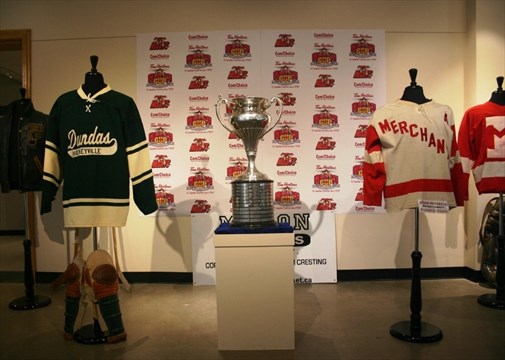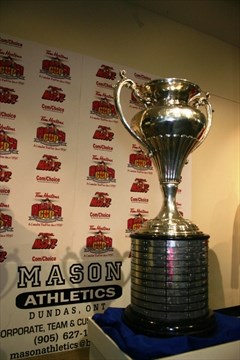Hockey and history mingle in Dundas Museum
It's a small display, but it's dense with history and relevance. 
As a prelude to the Allan Cup tournament, which opens at the J.L. Grightmire Market Street Arena in two weeks, the Dundas Museum and Archives — one of this area's underappreciated little gems — will be the temporary home to the Cup itself until at least next Wednesday. Fans can have their picture taken with the trophy, which will be presented to the senior hockey champions of Canada after the final April 19.
The Allan Cup has been up for competition since 1890 and the hardware at the museum is the actual beaker presented to the players on the ice. The original Allan Cup rests permanently, and safely, at the Hockey Hall of Fame.
As well as the trophy, the display tribute to the Allan Cup tournament includes a number of artifacts and hockey sweaters lent to the Museum and Archives by Brian Mason of nearby Mason Athletics Sportswear.
There's an old Dundas Merchants' intermediate sweater, once worn by local hero Bill (Red) Searle, plus a Blues' Junior C sweater, a Real McCoys' senior sweater, a "Hockeyville" sweater from 2010 (when Dundas won the Hockey Night in Canada contest and played host to an NHL pre- season game between the Buffalo Sabres and the Ottawa Senators), and a commemorative sweater from the 2014 Allan Cup tournament (another photo op). 
And above a small display case a projector transmits images of old shinny pictures onto the wall, reminding the visitor of the depth and breadth of the history of Dundas hockey. There are photos of the construction of the Market Street Arena, of the D.U.M. men's team — eight guys holding their one-piece wooden sticks — that won something called the Wilson Trophy in 1905, the Mountainview Dairy Intermediates from the 1950s and one of the 1944 girls team at Dundas Central Public School, taken on the school's outdoor rink.
Anyone — mainly we outsiders — who had to rely upon the yellow "Dundas Arena" directional sign at the upper end of King Street in order to find the Market Street Arena will be overjoyed to see that it's part of the museum display. When the arena was updated a couple of years ago the sign, a local landmark, was removed.
"I got a call from a friend who said that it had been thrown out and was going to be destroyed," Brian Mason recalls in his downtown store, which serves as a de facto hockey museum.
He rescued the sign and, other than this week, it sits in his store, illuminated by Christmas lights.
Speaking of illumination, a black and white photo in the display case sheds some light on the strong history of competitive men's hockey in Dundas over the past half-century-plus. It was taken during the 1950-51 hockey season and shows the first minor hockey team to play in the Market Arena.
Searle is one of the young players and, in the back row, is the town's former police chief, Earl Jack, wearing his uniform, as Dundas Police became the chief sponsor of minor hockey.
Jack was a huge supporter of hockey and of other healthy pursuits for local kids. After he suffered a debilitating stroke in 1955, hockey tried to pay him back.
In a plot line that long predated the same concept in the movie Mystery,Alaska, the New York Rangers came all the way to Dundas in February of 1956 — in the middle of the NHL season, remember — to play an exhibition game against the Dundas juniors (including Searle), who were bolstered by five players from the Leaside juniors. The Rangers, who held their pre-season training camp in Guelph in those days, were affiliated with both junior teams.
More than 1,500 people shoehorned into the Market Arena to see the game, which the Rangers, with stars such as Andy Bathgate and Hamilton's Harry Howel, won 10-3, a margin that could have been much broader without the heroics of Dundas goalie Meco Poliziani.
The proceeds from the game were donated to the Earl Jack Fund. But, according to Mason, a group of adult minor grads, stimulated by the game and the interest it generated, thought it would be possible, and fun, to ice a men's team for an entire season, not just a one-off.
It's only a mild stretch to suggest that Dundas' umbilical connection to the men's game started right there. Less than a half-decade later, on their way to the 1960 Squaw Valley Olympics, the German National Team stopped in Dundas to play the intermediate Merchants.
Senior and intermediate is the hardest level of hockey to sustain but, relative to the rest of the country, Dundas has been pretty successful at keeping it alive.
Exhibit A is the national tournament which begins there in less than two weeks.